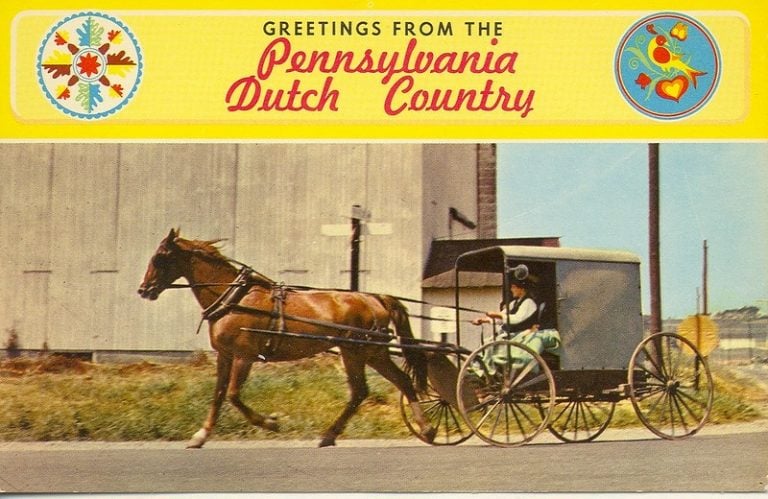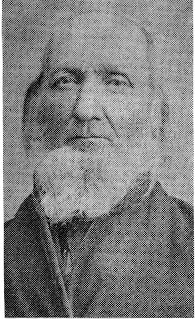History of Amish names: A ‘Smiley’ Amishman by way of the British Isles
David Luthy shares the history of Nathan Smiley, born in Ireland to a British mother in 1797.
At age four, Nathan arrived in America with his mother, and for reasons unexplained was placed in a foster home in Somerset County, Pennsylvania. That home happened to belong to an Amish family. On coming of age, Nathan chose to join the Amish church, and later married. Nathan Smiley had two sons by his first wife, and two daughters and a son by his second.
Later, a group of Amish set out west in search of a suitable location for a new settlement. It’s unclear, but either Nathan or his son John, eighteen at the time, was among the four Amish who left in search of cheaper land in 1840.
Traveling by flatboat and steamboat, the men made their way to Iowa, where the timber impressed the men, but not the soil, nor the apparent malaria outbreaks in the region. Next stop was Chicago, which Luthy notes at the time was but a town of just 4,000 souls.
Via Lake Michigan and next the St. Joseph River, the band made their way into northern Indiana, and to the area near Goshen in Elkhart County. The land turned out to be suitable, and it was decided that this place would become their new home.
In 1841 Nathan Smiley moved to Elkhart County, among the first families to settle in what would become the third-largest Amish community today. Settlers from Pennsylvania and Ohio contributed to the growth of the fledgling community.
Later, church issues arose in this area as they did in other Amish communities. In the mid-19th century, the Amish began to forge separate paths which led to their ultimate division into two groups: the progressive Amish-Mennonite group, which gradually assimilated to a greater and greater degree with society, and the Old Order Amish.
Alas, “Smiley” is among the monikers Luthy lists as “Names Which Came and Went Again”.
At some point, Nathan Smiley’s son John, chosen a minister in 1849,decided to join the more progressive group. Luthy writes that it is believed his father did as well. No mention is made in Luthy’s account of what happened with Nathan Smiley’s two other sons, but one would assume that at some point they opted not to be a part of the Amish church.
And when John Smiley passed away of heart failure in 1878, the fact that he had joined the Amish-Mennonites made little difference to his name surviving among Amish, as he had had seven daughters, and not a single son.
Had “Smiley” survived, it would be the second-cheeriest last name among the Amish, after “Peachey”, of course.
(Source: David Luthy, “New Names Among the Amish Part 5: Names Which Came and Went Again”, Family Life, June 1973)
Histories of other Amish names:







As an Irish Anabaptist I find it encouraging to hear of fellow country people who went before me on the Anabaptist path.
However I find it offensive that to this day people still assume that Ireland is still a part of England (or “britain” as the English like to say).It’s akin to saying that Poland is still under Russian Soviet rule.
As an added comment, I do know some Irish people with the Smiley surname.
"British Isles" includes Ireland as well
Hi Lucy,
Appreciate the comment! Thanks for sharing this, I think you may be referring to the post title using “British Isles”? Actually I am aware of the geographical issues, that Ireland and England are very separate places and Ireland is not Great Britain nor part of the UK. However I chose this term because as I understand it, “British Isles” can refer to both Great Britain and Ireland as well as the numerous thousands of other isles including the Isle of Man, etc taken all together.
I know it’s probably not the most common usage nowadays, but since Nathan Smiley had a British mother, and since the source I was referencing was a little unclear as to his father’s nationality and why he was born in Ireland and not Britain, I went with the wider geographical term of “British Isles”. Might be a less common usage but as I understand (hope I’m right here) it should still be technically accurate. I can understand why it might be somewhat controversial as well.
And, yes, it is slightly irksome to hear Poland occasionally still referred to as “communist” or “the same as Russia”, but I usually make a joke about polar bears roaming the streets and then get a good laugh out of it to boot.
And that is interesting to hear you know this surname as well. Luthy mentions that there are other spellings as well, such as “Schmeily” or “Smyly”.
Thanks for reading, and by the way you have great photos on your blog!
Erik
Thanks Erik.
I’m a direct descendant of Nathan Smiley and have heard the story of him being taken in by an Amish family since I was a child. My family faithfully went to the Smiley reunion every year. I grew up near Smithville, Ohio. I can’t remember exactly where the reunion was held. As a kid, it was my least favorite reunion because I didn’t know other people there and there never seemed to be other kids to play with!
I now live in Goshen, Indiana, near the site of Nathan and John Smiley’s farms. The original farmhouse is now a restaurant. I enjoy going in there (a two-story brick house) and imagining my ancestors running up and down the open staircase.
Thanks for the helpful information!
Nathan Smiley's House Is Now a Restaurant
Nathan Smiley was my great, great, great grandfather. John Smiley was my great, great grandfather. My husband and I went to the Elkhart Prairie Cemetery near Goshen, Indiana and found Nathan’s gravestone.
You mentioned that there is now a restaurant at his farmhouse. What is the name of the restaurant? What is its address?
Our family could have attended the Smiley Reunion, but we never went. It was started by John Smiley’s wife, Mary Conrad Smiley who lived from 1825 – 1812. She wanted to have her daughters and their families together in the summer. First they met at her house, then at other houses and then eventually at Orr Park in Orrville, Ohio. Later the Smiley Reunion combined with the D.Z. Yoder Reunion also held at Orr Park. We did attend the D.Z. Yoder Reunion. D.Z.Yoder was John and Mary Smiley’s son-in-law and my great grandfather.
Carolyn Geiger
Smiley reunion
Sharon, great to hear from you, and with the names you are sporting, how could you not have Amish blood 🙂 I did not know there was a Smiley reunion…boy the quips one could come up with 🙂 🙂 🙂
Next time I am in N. Indiana I’ll need to figure out just where the Smiley farms are!
Nathan,my great great grandfather, John my great grandfather
I went to all the Smiley reunions and they were in Orville Park. I grew up on John Smiley’s farm near Smithville and Wooster Ohio. I have the family history of the Smiley’s. I am 85 so the history was all around with relatives close by. I now live in Reedley Cal and am still a Mennonite.